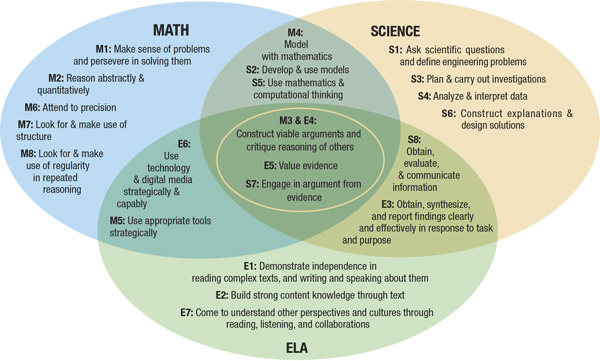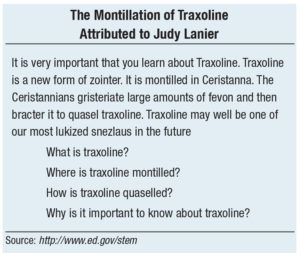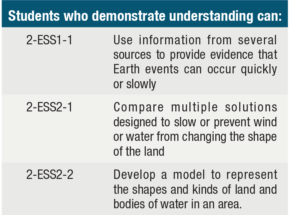Get a piece of plain paper and draw a “scientist.” Did you draw a crazy-haired white male with glasses, a lab coat, and exploding beakers and test tubes in the background?
Since the early 1980s, this test has been done to evaluate children’s perceptions of scientists. In 1983, D.W. Chambers published “Stereotypic Images of the Scientist: The Draw a Scientist Test.” In this original test, out of nearly 5,000 students tested, 28 girls, and no boys, drew female scientists Even before then, anthropologist Margaret Mead and her colleague, Rhoda Metraux, studied high school student responses to questions about the image of the scientists, with both girls and boys mostly describing male scientists.
More than 50 years after this line of inquiry began, the stereotypes and the narrow image of who can be a scientist persist. Research indicates that negative images of scientists lead to negative attitudes about science. No wonder our country lacks young adults who want to major in the STEM (science, technology, engineering, and mathematics) fields.
Why We Need New Science Standards But it’s not just that students can’t imagine themselves as scientists – many aren’t properly prepared to pursue a STEM career. Not enough of our youth have access to quality STEM learning opportunities and too few students see these disciplines as springboards for their careers. According to the U.S. Department of Education website, only 16 percent of American high school seniors are proficient in math and interested in a STEM career.

The perceptions about STEM education are widespread. A 2015 Pew Research Center study found that only 29 percent of Americans rated their country’s K-12 education in science, technology, engineering and mathematics as above average or the best in the world. Scientists were even more critical: A companion survey of members of the American Association for the Advancement of Science found that just 16 percent called U.S. K-12 STEM education the best or above average; 46 percent, in contrast, said K-12 STEM in the U.S. was below average.
American students are scoring higher on national math assessments than twenty years ago, but they still rank in the middle of international comparisons in science and math, behind many other advanced industrial nations, ranking 29th in math and 22nd in science among industrialized nations.
Why is this sluggish ranking worrying? Perhaps the Carnegie Foundation put it best in 2007: “The nation’s capacity to innovate for economic growth and the ability of American workers to thrive in the modern workforce depend on a broad foundation of math and science learning, as do our hopes for preserving a vibrant democracy and the promise of social mobility that lie at the heart of the American dream. However, the U.S. system of science and mathematics education is performing far below par and, if left unattended, will leave millions of young Americans unprepared to succeed in a global economy.” Additional evidence of the reduction of the United States’ diminishing competitive edge is that foreign competitors filed over half of U.S. technology patents in 2010, according to the National Science Foundation.
The graph on the right side of this page shows how the expected job growth in some of the STEM fields exceeds the rate of growth of all occupations. Young people who pursue STEM-related careers face brighter job prospects than others.
But it’s not just would-be scientists who can profit from a solid education in STEM topics; everyone needs the knowledge and understanding of basic scientific concepts in order to become productive, informed citizens. As the National Research Council stated in 1996, “Scientific literacy is the knowledge and understanding of scientific concepts and processes required for personal decision-making, participation in civic and cultural affairs, and economic productivity.”
The Old Way of Teaching Science One example of why science should no longer be taught the way most of us learned it will suffice to illustrate my point. Below is an example of how science has traditionally been taught and tested – information is conveyed and then the student is asked to regurgitate it, without using any critical thinking skills. Despite the incomprehensibility of the passage, it is entirely possible to answer the questions without any understanding of the subject matter. Here is the example:

Of course, it is easy to get all the answers correct. But will you remember anything about traxoline by the end of reading this article?
One of the basic shifts in the new science standards is the change in focus from memorizing facts to actually figuring out by doing science. The goal is for students to spend more time posing questions, discovering the answers for themselves, and applying their knowledge to real situations.
How Were the Standards Developed? A brief look at the past reveals some major pushes toward common national standards. In 1983, the federal report A Nation at Risk raised alarm about the quality of the nation’s education system. In 1989, the National Council of Teachers of Mathematics (NCTM) published a set of standards for teaching mathematics, based on consensus from many teachers and mathematics experts.
In 1993 Benchmarks for Scientific Literacy was published by Project 2016, and stated what all students should know and be able to do in science, mathematics, and technology by the end of grades 2, 5, 8, and 12. The recommendations at each grade level suggested reasonable progress toward the adult science literacy goals laid out in the project’s 1989 report Science for All Americans.
The National Research Council (NRC), the staff arm of the National Academy of Sciences, began work on the Next Generation Science Standards by developing the work, A Framework for K–12 Science Education. The Framework, which was released in 2011, was a critical first step because it is grounded in the most current research on science and science learning and identified the science all K–12 students should know.
To undertake this effort, the NRC convened a committee of 18 individuals who are nationally and internationally known in their respective fields. The committee was composed of practicing scientists (including two Nobel laureates), cognitive scientists, science education researchers, and science education standards and policy experts. In addition, the NRC used four design teams to develop the Framework. These design teams, in physical science, life science, earth/space science, and engineering, each developed the Framework for their respective disciplinary area. After the Framework was released, the states led the development of K–12 science standards that are rich in content and practice and arranged in a coherent manner across disciplines and grades to provide all students an internationally-benchmarked science education. The Next Generation Science Standards (NGSS) are based on the Framework and will prepare students for college and careers. The NGSS were developed collaboratively with states and other stakeholders in science, science education, higher education, and industry.
How are the New Science Standards Different? There are several major differences between the old standards and the NGSS. First, the new standards are written as performance expectations, in other words – what students should know and be able to do. They are based on the Framework, and are designed to be assessed in real-world contexts. Engineering and the application of scientific concepts are integrated. The standards are written with explicit connections to the Common Core standards in mathematics and English language Arts. (See Venn diagram.) Most importantly, the expectation is that students will be prepared for college, careers, and citizenry.
American curriculum has often been criticized for being a “mile wide and an inch deep.” In the new science standards, fewer topics are covered in each grade level, and students are thus provided the opportunity to deepen their understanding and apply their knowledge to solving practical problems.
The Three Dimensions of the NGSS The Next Generation Science Standards consist of three dimensions: disciplinary core ideas (the content in life, physical, earth and space science), the cross-cutting concepts, (linking themes between content areas), and the scientific and engineering practices. The cross-cutting concepts include patterns; cause and effect; scale; proportion and quantity; systems and system models; energy and matter, flows, cycles and conservation; structure and function; and stability and change. Each of these concepts connects core ideas across all the disciplines of science. For example, there are life cycles, earth materials cycles, and atmospheric cycles.
The scientific and engineering practices in the science standards are:
- Asking questions and defining solutions;
- Developing and using models;
- Planning and carrying out investigations;
- Analyzing and interpreting data;
- Using mathematical and computational thinking;
- Constructing explanations and designing solutions;
- Engaging in argument from evidence; and
- Obtaining, evaluating, and communicating information.
Arguing from evidence is a major expectation in English language arts (example: persuasive essays) and in math (explaining how an answer is derived). A major shift is that “cookbook” labs, where students follow a procedure, already knowing the outcome and explained by the teacher, are replaced by investigations designed by students and stimulated by students’ questions and interest in solving a problem.
The practices describe “behaviors that scientists engage in as they investigate and build models and theories about the natural world and the key set of engineering practices that engineers use as they design and build models and systems.” The idea is for students to be scientists and recognize that scientific investigation requires both knowledge and skill.
Contrasts Between the Old and the New There are three areas of contrast between current practice and the approaches to teaching and learning articulated in the Framework and the NGSS. They can be described as the kind of ideas we target for K-12 education (explanatory core ideas); how they are built (practices); and how they need to fit together (coherence).
It is important to recognize that the standards are designed with the idea that students can develop deeper understanding of fewer concepts. Learning is progressive and students build a more sophisticated knowledge of concepts as they get older. Understanding builds over time. Research shows that children are naturally curious and much more capable of abstract reasoning than previously thought. Inquiry and explanation can thus be introduced in the early grades.
A Second-Grade Lesson on Erosion An example of one of the standards for second grade earth science follows:

The Role of the School Board The NGSS represent a major paradigm shift in the way science is taught. Teachers will need the support of the board and school administrators to provide professional development so that curriculum can be re-aligned. Teachers need to learn how to transition from the role of “giver of knowledge” to a facilitator role and learn how to bring students to the point of being able to ask questions and design investigations on their own. This is definitely not easy and the curriculum must be thoroughly examined. It cannot simply be “tweaked” to meet the new standards. Teachers will need to learn how to teach science differently by incorporating all three dimensions in their lessons.In this lesson, students work in groups and create sand castles using sand, cups, and aluminum roasting pans. They can blow on their formation with a straw and observe what happens. They can drip water on the formation or pour water on them to see how the sand “erodes.” Next, they design and create a barrier that would prevent the erosion. They test their solution, re-design if necessary, and draw conclusions while arguing from the data and evidence they have collected. How do the students become engaged? The teacher begins by presenting a real-life scenario, also called a storyline, like Hurricane Sandy, to pique student interest.
Most elementary teachers are generalists, having to teach all subjects. Often, they are not comfortable teaching science because they simply do not have the science background that subject specific teachers in the secondary grades do. Even the secondary teachers with the requisite content knowledge have to drastically change the way they teach. It is easy to lecture, require memorization, and be the expert; it is not easy to turn the classroom over to students and have them take responsibility for designing and implementing investigations, driven by their own questions and curiosity.
It will take time for teachers to become comfortable with this huge paradigm shift. Board members and administrators must allocate resources to provide the support teachers will need. Often elementary teachers want a book or a pre-packaged program that they can use to address the new standards. Doing science is not the same as reading about it in a book. The money is better spent on providing the training and materials (not necessarily textbooks) needed for students to do science!
Assessment How will be the NGSS be assessed? According to Michael Heinz, coordinator of science at the New Jersey Department of Education, “The NJASK 8 and Biology assessment will be transitioned in the spring of 2017. The test will look exactly like it does now.” He explained that all of the items will map to the 2009 science standards and the NGSS. The state’s goal is to transition to an online platform for the NGSS assessments in the spring of 2018. “The items will be two-dimensional. That is, the items and tasks will assess proficiency with both the practices and the disciplinary core ideas simultaneously,” said Heinz in correspondence. The state plans to use the National Academies’ book entitled Developing Assessments for the NGSS as well as the Council of Chief State School Officers’ documents entitled Item Specification Guidelines and Assessment Framework to inform the system of assessment that is envisioned.
The vision of the Next Generation Science Standards requires a dramatic departure from approaches to teaching and learning science occurring today in most K-12 science classrooms. The Framework and NGSS have the potential to move our K-12 science education system forward in important ways. We know that the type of ambitious teaching reflected in NGSS is possible, occurs in some modern classrooms, and leads to impressive engagement and learning for students. With the appropriate professional development and the support of the school board members, chief school administrators, and principals, we could see a dramatic shift in science learning and teaching.
Online Resources
The following websites provide a wealth of information on the new standards.
Next Generation Science Standards
The National Science Teachers Association
The New Jersey Department of Education science standards page
Author References
Chambers, David Wade, (1983).Stereotypic Images of the Scientist: The Draw-A-Scientist Test, Science Education. Volume 67, Issue 2.
Mead M, Métraux, R (1957). Image of the Scientist Among High-School Students: A Pilot Study. Science. Aug 30;126(3270):384-90.
https://www.ets.org/Media/Research/pdf/PICNATEDSTAND.pdf
http://nextgenscience.org/development-overview
http://onlinelibrary.wiley.com/doi/10.1111/j.1949-8594.2002.tb18217.x/abstract
http://www.project2061.org/publications/bsl/
Reiser, B. (2013). What professional development strategies are needed for successful implementation of the Next Generation Science Standards? Paper written for the Invitational Research Symposium on Science Assessment.
Science and Engineering Indicators: 2012. National Science Foundation http://www.nsf.gov/statistics/seind12/c6/c6h.htm#s4
http://spu.edu/depts/uc/response/new/2012-spring/features/history-of-reform.asp
